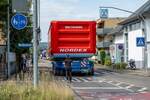innogy is setting the course for the future: investments of billions of euros planned
Today, the Executive Board and the Supervisory Board of innogy SE agreed on the budget for fiscal 2018. With this, innogy is setting the course for the future. The Executive Board released its forecast for 2018 on this basis. Development in the coming fiscal year will be characterised above all by increased ramp-up costs for strategically important projects such as digitisation and by substantially higher investments in future-oriented business fields such as e-mobility, renewable energy, and broadband. Furthermore, the non-recurrence of positive one-off effects felt in 2017 will have an impact on earnings.
Peter Terium, Chief Executive Officer of innogy SE: “We are a trailblazer of change. We do not wait to see what happens – we set trends. This is why we have deliberately decided to make huge investments in the future and banking on e-mobility, renewable energy and ultrafast internet. We are driving the energy transition in Germany and at the international level. High growth ambitions initially come at a price, but pay off in the long run. At the same time, we are making all our divisions fit for the digital future. And that does not come for free, either. Even if this will weigh on our earnings short-term, I am convinced that this is the right strategy for setting up innogy optimally for the future – entirely in the interests of our shareholders, customers and employees.”
Adjusted EBIT at the Group level is expected to total about 2.7 billion euros in 2018. Reduced earnings prospects cloud expectations compared to 2017 in the retail business. Adjusted EBIT is also expected to be slightly down year on year in the grid business, where innogy benefited from positive weather-related effects in 2017 particularly in Eastern Europe. Special items had a positive impact on both divisions in 2017, the extent of which will not recur in 2018. The Renewables division is expected to display stable development. From today’s perspective, the Group’s adjusted net income is expected to be above 1.1 billion euros. innogy continues to base its dividend on a payout ratio of 70 to 80 per cent of adjusted net income. To spur growth, innogy plans to increase capital expenditure by at least 25 per cent in 2018 to over 3.0 billion euros compared to the current fiscal year.
Furthermore, innogy SE made a slight adjustment to its forecast for the current financial year 2017 today. Now innogy anticipates adjusted EBITDA in the order of about 4.3 billion euros (previously about 4.4 billion euros) and adjusted EBIT of about 2.8 billion euros (previously 2.9 billion euros). This is primarily due to the persistently difficult market environment in the UK retail business. Here, the measures of the ongoing restructuring programme are not sufficient to offset negative market effects. Moreover, there has been a rise in costs at the Group level incurred for central future-oriented projects, e.g. digitisation and process optimisation, as well as expenses associated with growth initiatives, e.g. in the field of e-mobility. Additional efficiency measures can only partially offset this development. As before, adjusted net income is expected to be above 1.2 billion euros, albeit not significantly.
|
Outlook€ million |
2016 actual |
2017 forecast |
2018 outlook |
|
Adjusted EBITDA |
4,203 |
About 4,300 |
- |
|
Adjusted EBIT1 |
2,735 |
About 2,800 |
About 2,700 |
|
Renewables |
359 |
About 350 |
About 350 |
|
Grid & Infrastructure |
1,708 |
About 1,900 |
About 1,850 |
|
Retail |
844 |
About 800 |
About 700 |
|
Adjusted net income |
1,123 |
Above 1,200 |
Above 1,100 |
1 ‘Corporate/other’ not stated separately.
Forecast for 2017: UK recovery slowed despite successful efficiency programme
It had already become apparent over the course of 2017 that the earnings prospects in the UK retail business are still dim. By the end of the third quarter of 2017, npower managed to implement about 150 million euros in cost-cutting measures via the restructuring programme that was launched in 2016. However, the market environment remains tight. Many customers can only be retained by switching them to tariffs with more favourable conditions. Furthermore, higher run-up and procurement costs cannot be fully passed through to customers. innogy no longer expects the additional efficiency measures to suffice to fully offset the earnings shortfalls throughout the entire retail business. In addition, innogy has stepped up its growth ambitions in the field of e-mobility even more this year. innogy now anticipates adjusted EBIT in the retail business in the order of about 800 million euros.
The earnings outlook in Grid & Infrastructure (adjusted EBIT of about 1,900 million euros) and Renewables (adjusted EBIT of about 350 million euros) remains unchanged.
Outlook for 2018: Increased ramp-up costs for future-oriented projects, higher additional growth capex and non-recurrence of positive special items
At about 2.7 billion euros in adjusted EBIT, the earnings expected in fiscal 2018 are down year on year. This is predominantly due to higher ramp-up costs for future-oriented projects. Moreover, lower earnings in the retail business in Germany will have an impact, where innogy benefited from positive effects in earlier years – in particular of the reversal of provisions in connection with legal risks. The UK retail business will probably be stated as a ‘discontinued operation’ (DCO) from some point in 2018 onwards. Therefore, its earnings will no longer contribute to the Group’s adjusted EBIT and will instead be stated separately in the reconciliation to net income. This is because of the agreement reached in November 2017 to merge innogy’s British retail business npower with SSE’s household energy and energy services business in Great Britain to form an independent listed British energy retail company. innogy will hold a minority stake of 34.4 per cent in the combined retail company. In the other retail markets, innogy will continue to focus on efficiency-enhancing measures with the aim of defending its good market positions. innogy anticipates that the Retail division will achieve an adjusted EBIT of about 700 million euros in 2018.
In the Grid & Infrastructure division, innogy benefited from the relatively cool weather in Eastern Europe in 2017. As usual, normalised weather conditions are assumed in the 2018 budget. The beginning of the new gas regulation period in 2018 in Germany will also have a negative effect on earnings. Furthermore, one-off effects felt in 2017, resulting among other things from reversals of provisions, are not expected to affect the coming year as positively as the current one. Moreover, the gas storage business continues to face a challenging market environment and is expected to experience a further shrinkage in margins. In sum, this division’s adjusted EBIT is currently expected to total about 1,850 million euros.
innogy anticipates that the Renewables division will post earnings in 2018 on a par with fiscal 2017, thus an adjusted EBIT of about 350 million euros. This is based on normalised weather conditions. Below-average wind and precipitation levels are weighing on earnings in the financial year underway. Furthermore, innogy intends to put more capacity online, including the full commissioning of the Galloper offshore wind farm in the United Kingdom (353 megawatts; innogy share: 25 per cent). The fact that innogy benefited from the one-time effect of the revaluation of the Triton Knoll offshore wind project following the initial full consolidation in 2017 will have a counteracting effect.
innogy expects expenses in the Corporate/other segment to be lower than in 2017, although high project costs – incurred for example for the digitisation and modernisation of IT systems and their separation from RWE – will continue to curtail earnings.
The adjusted financial result anticipated by innogy is in the order of about minus 750 million euros, as positive one-off effects felt in 2017 will not recur. The effective tax rate used to calculate adjusted net income is estimated to range between 25 and 30 per cent.
As a result, adjusted net income will also be weaker than in 2017. innogy currently anticipates a figure of above 1.1 billion euros.
More than 3.0 billion euros in capital expenditure planned in 2018
The Executive Board of innogy SE has approved a capex budget of over 3.0 billion euros for fiscal 2018, more than 25 per cent above the figure expected for 2017.
The expansion and modernisation of network infrastructure will continue to be a focal point of innogy’s investing activity in 2018. Besides maintenance, the connection of distributed generation assets and grid expansion in relation to the energy transition will take centre stage. Moreover, innogy intends to continue to grow in the field of broadband technology – in Germany as well as in Eastern Europe.
As regards renewables, innogy intends to further expand its capacity in the years ahead. Owing to the successful participation in this year’s UK auction for the subsidisation of renewable energy, the Triton Knoll offshore wind project (innogy share: 100 per cent) with a planned capacity of 860 megawatts will be a major capex target. At present, innogy is assessing various options for commercially optimising the project, including partnership models and financing structures. The final investment decision for Triton Knoll is set to be taken in mid-2018. Also in 2018, onshore works are scheduled to begin to provide the grid connection. Based on current plans, commissioning of the wind farm could be started in 2021. The planned investment volume amounts to approximately 2.0 billion British pounds (roughly equivalent to 2.2 billion euros, based on the current exchange rate). Growth in onshore wind is to focus strongly on the US where concrete investment options are currently being evaluated. Concrete investment options in various markets are also being explored in the field of solar power, with a view to establishing this field of business.
Capital expenditure in the retail business will focus above all on the modernisation of IT infrastructure. In e-mobility, all signals point to growth: innogy intends to strengthen its good starting position even more. In 2018, this business field requires investments to accelerate growth, but as expected will not yet generate significant earning contributions in the short term. In addition to organic growth, options to supplement the portfolio through selective acquisitions are also being explored – especially in Europe and North America.
- Source:
- innogy
- Author:
- Press Office
- Link:
- news.innogy.com/...
- Keywords:
- innogy, investment, Triton Knoll, onshore, offshore























